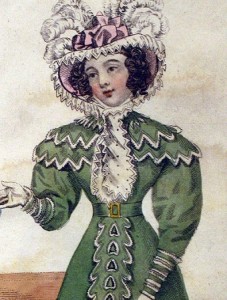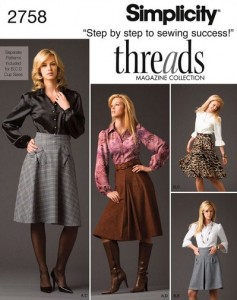
Those of us who make Victorian dresses are all after one particular feature – a small waist. We do this primarily through corset cinching but also a visual trick with wide sleeves and full skirts.
Another hidden method is to reduce the amount of fabric layers around your waist, specifically on skirt layers. When you don a corded petticoat, ruffled petticoat, plain petticoat then a fashion fabric skirt, all those layers can add a significant amount to a waistline you are so desperately trying to appear small.
You may have heard to set all your petticoat skirts onto one waistband. That’s a good solution. But I have a better one. One that avoids a thick seam allowance all bunched up into a thin waistband.
A yoke.

A yoke is a smooth, fitted area of fabric around the waist and hips where the lower pieces of a skirt are sewn onto the bottom edge or even up on the yoke itself. This section of a skirt reduces the amount of fabric around the body area, making fewer layers around your waist. Yay!
I will say upfront that in my research I believe that combining petticoat layers onto a yoke is a modern solution. I’ve not come across (that I recall) a 19th Century petticoat garment made with a yoke or several layers onto one waistband. Even in the early 1900s I’ve seen no more than two layers set onto the same waistband.
So if you shy away from modern techniques in your historical clothing, continue with making single layer petticoats.

The corded petticoat shown here has a smooth fitted yoke that ends at the full hip line. The skirt portion is sewn directly onto the lower edge then seam allowances serged together.
What’s great about using a yoke for Victorian petticoat layers is that you can stagger the petticoat skirts on the yoke. This reduces seam bulk. Y0u’ll want to put the top petticoat layer either into the waistband (gathered to fit the top of the yoke) or about an inch below the waist seam.
You can attach as many petticoat skirt layers as you can fit onto the yoke. However, if you sew on more than two I would advise the yoke be made of firm fabric like a twill/denim or even coutil if your petticoats are very heavy.
So how do you get a yoke pattern to use for petticoats? Ideally, draping (over your corset) is highly recommended. That way you get a snug fit.
But what if you just want a pattern that’s quick for a down-and-dirty, get-the-gosh-darn-petticoat-done petticoat? Simple. Use a modern skirt pattern.
Like this older pattern from Simplicity:

Browse through the Big 4 pattern lines (Simplicity, McCall’s, Butterick & Vogue) or even indie lines for a basic A-line skirt. You’ll want to find one with a waistband if at all possible, but it wouldn’t be hard to use a skirt with facing pattern and add a waistband to it.
Cut the pattern at the hip line or slightly below and make sure it falls perfectly parallel to the floor when you’re wearing it. Do a quick fitting to take in the sides if you want a closer fit.
Ignore the zipper (’cause there’s probably one there in the side seam or at center back). Make a narrow hem from the seam allowance for the opening and close the waistband with a drawstring. Or add a placket and waistband overlap and add a skirt hook to close.
For the petticoat skirts, draw in seamlines for the number of layers you want, all of them parallel to the yoke lower raw edge (the one you’ve already made even with the floor). Measure from each seamline at center back to the desired length of your petticoat layers. The topmost layer should be slightly longer than the rest at the hem to smooth out all the edges as a separate top petticoat would be under a skirt.
Make up each layer with a finished hem then stitch to the yoke. Set on the waistband and you’re done! Now you only have one petticoat undergarment to put on when dressing in your multiple Victorian layers. 😀
Have you ever used a yoke for your layers of petticoats?

There are contemporary patterns for knitted Victorian petticoats with a yoked top.
I’ve read that in the first half of the Victorian era, the bodices actually ended just above the natural waist so that the petticoat waistbands/drawstrings bulk was below the dresses’ waistline, eliminating the build-up. Since those women had grown up wearing corsets everyday, their figures could still produce a small waistline at that level, something most women today cannot, even if they are waist-training. Also, said petticoats weren’t necessarily sitting exactly at the natural waist, but worn slightly loose to rest on the hips more (only about an inch or so). It’s only quilted petticoats that I’ve ever seen with any kind of yoke, and that’s usually more like 12 inches, if the majority of the petticoat is quilted (some were reversed, 12″ quilted at the hem and the rest plain to the waist). When we get to the Natural Form Movement, then we start seeing shaped waist-bands for the sleeker silhouette, but still not true yoked petticoats. Funny thing, the 1876 fashion shift was inspired by Revolution-era gowns, which also often had shaped waistbands on their petticoats to help the pointed bodice lay smoothly.
I make Ren costumes mostly for fellow actors. I have issues with hoops putting to much strain on my back. I think I can incorporate this idea into supporting the fullness I need for my skirts. I’m going to give it a try anyway. Thanks so much!
It’s a great idea. Now, do the petticoats go over or under the bustle/hoop?
You want petticoats over your wired bustle or hoop to disguise the wires and present a smooth skirt. For modesty in larger hoops an under-petticoat is a good idea.
Ok, thank you for this. I am collecting patterns, materials and other such things for when I make a “Romantic” era dress…so this will help a lot as my middle is not so little anymore! Wonderful post! Thank you!
I using joked waistbands myself, I have not found many originals like this, however there are plenty of fashion plates that show a construction was fairly common place, at least by 1870. I place buttons at the side, and it draws with cords at the back of the waist to the side, this added “bulk” adds just a little more fullness to the back, it also allows you to wear it below the waist line.
Another point to think about is that many corsets of the era feature a large hook 2 to 3 inches below the waist. Granted different corset historians have different stories about it’s purpose (I mean who would REALLY attach their bust improver down THERE), I firming believe it’s function was more to keep waist bands, bustle straps from riding up to waist, it seems to work perfectly for all of my work.
https://www.facebook.com/photo.php?fbid=10150349971539137&set=a.411087949136.173228.278078454136&type=3
Great article! I’d like to echo Karen Ann’s comment that making the petticoat waistbands 1″ larger than the waist lets them sit just a little lower on the waist. That way you don’t have waistbands stacked on top of each other, but you also don’t loose the extra fullness just below the waist that helps the skirts look full enough. 🙂
There are actually are a fair number of yoked petticoats from the 19th century, but they’re all (AFAIK) quilted and/or heavier woolen. The quilting is not something our foremothers wanted to deal with wadding into a waistband!
Yes, many yoked petticoats exist. However, the modern trick here is to taper many petticoat skirt layers all onto one yoke.
Sitting the waistband lower is another good trick to try. (That is if you don’t need that “poofy hip look” of the 1840s/50s. 🙂 )
I found a yoked, corded petticoat here:
http://www.corsetsandcrinolines.com/timelineitem.php?index=185035
Another hint is to make the waistband lightly larger than your own waist measurement so the petticoat hangs on the top of your hips, not right at the waist.
That’s almost exactly what I do! I also make sure that each petticoat is tied a bit higher than the one below it, since I prefer drawstring waists for my petties. So if I’m wearing three, I’ll wear a shortened one tied at the hip, a slightly longer one tied higher on the hip, and my best (and longest!) one tied at the waist. That way, the fullness stays on my hips and butt, where I want it, and there’s only one layer – the prettiest one – at waist height. Sure, nobody is likely to be seeing any more of my petticoats than perhaps a hint of lace when I need to raise my skirts for climbing stairs and the like, but I love pretty underthings! Nobody’s supposed to be seeing my corsets either, but I still make them from silk, with plenty of lace, ribbon, and embroidered trim, just like I love beautiful, lacy modern lingerie. A love of pretty undies is timeless. 🙂
I do this as well!
I personally can attest to the usefulness of a yolked petticoat! Bridal flounced petticoat over a 12 foot hoop demands much more support than a single waistband! They work a treat.
Another option for fitting one (since we’re dishing modern methods) is to do a sacrificial duct tape pattern over the area you want covered. Similar to a duct tape double, but you cut it apart as your personal pattern!
Also, Jennifer, is there any printable costume planning sheets available on the wide web? I’ve been looking for a few days, just thought I’d ask! Thanks!
Duct tape pattern would be awesome! (I really should try that.)
What kind of planning sheet were you thinking of? Like one where you could sketch the design then add in notes for fabrics, notions, patterns, etc?